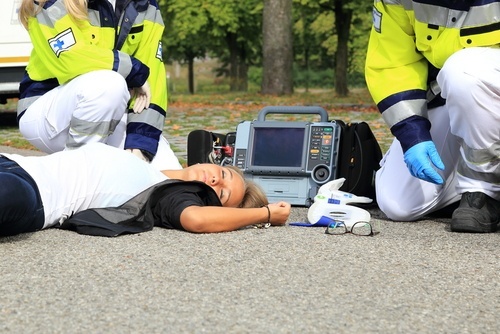California law allows you to recover damages for the negligent infliction of emotional distress (abbreviated NIED). This is not an independent cause of action. Rather, it is a basis for damages in a negligence claim.
Under California law, emotional distress damages can be claimed if you were either
- a direct victim of someone’s wrongful act, or
- a bystander who witnessed an injury to a close relative.
Damages for a plaintiff’s emotional distress can include both economic- and non-economic damages such as:
- Medical bills,
- Bills for psychological counseling,
- Lost wages, and
- Pain and suffering, including loss of enjoyment of life
To help you better understand the law, our California personal injury lawyers discuss:
- 1. What is emotional distress?
- 2. The Elements of a “Direct Victim” Claim
- 3. The Elements of a “Bystander” Claim for Emotional Distress
- Additional Reading

Plaintiffs in personal injury cases may be able to recover emotional injury damages for NIED claims.
1. What is emotional distress?
Emotional distress in California includes (without limitation):
- suffering,
- anguish,
- fright,
- horror,
- nervousness,
- grief,
- anxiety,
- worry,
- shock,
- mental distress,
- emotional harm,
- emotional trauma,
- humiliation, and
- shame.
Serious emotional distress exists if an ordinary, reasonable person would be unable to cope with the mental stress caused by the circumstances of the case.1
2. The Elements of a “Direct Victim” Claim
California Civil Jury Instructions (CACI) 1620 spells out the elements of being a direct victim of negligent infliction of emotional distress. For you to win a lawsuit, you have to prove by a preponderance of the evidence the following elements:
- The defendant exhibited negligent conduct, and
- As a result of the defendant’s negligence, you suffered serious emotional distress.2
Therefore, the jury must first ask if the defendant owed you a duty of care in California and – if so – did the defendant breach that duty through their mishandling of the situation? 3
If the answers are “yes,” the only question is whether a reasonable person, under similar circumstances, would be able to cope with the mental stresses placed on the you by the injury.4

Bystanders to a car accident may be able to recover NIED damages if they are closely related to the victim.
3. The Elements of a “Bystander” Claim for Emotional Distress
California Civil Jury Instructions (CACI) 1621 spells out the elements of negligent infliction of emotional distress as a bystander. For you to win a lawsuit, you must prove by a preponderance of the evidence the following elements:
- You are or were closely related to the victim,
- The defendant’s conduct negligently caused injury or death to the victim,
- You were present at the scene of the injury (“zone of danger”) when it occurred and were aware that the victim was being injured, and
- As a result of the injury, you reasonably suffered severe emotional distress beyond that which would be anticipated in a disinterested witness.5
Who is a “close relative” under California law?
In most cases, “close relative” means:
- A spouse, registered California domestic partner, or relative who resides in the same household,6 or
- Your parents, siblings, children, and grandparents.7
With the exception of domestic partners, “close relatives” do not comprise unmarried cohabitants – even if they have a “close relationship.”8
What does it mean to “witness” an accident?
To recover damages for bystander infliction of emotional distress, you must have been both:
- Present at the scene of the injury-producing event at the time it occurred, and
- Aware that the event was causing injury to the victim.9
If you heard the accident but were not immediately aware it was causing injury, you cannot recover damages for negligent infliction of emotional distress — even if you acquired the missing knowledge moments later.10
This does not necessarily mean that you must see the accident. It means, however, that you must have been aware at the time of the accident, through some sensory means, that your relative was being injured.11
Additional Reading
For more in-depth information, refer to these scholarly articles:
- A Principled Solution for Negligent Infliction of Emotional Distress Claims – Arizona State Law Journal.
- Is Negligent Infliction of Emotional Distress a Freestanding Tort – Wake Forest Law Review.
- Negligent Infliction of Emotional Distress: Coherence Emerging from Chaos – Hastings Law Journal.
- Evaluating Independent Torts Based upon Intentional or Negligent Infliction of Emotional Distress: How Can We Keep the Baby from Dissolving in the Bath Water – Arizona Law Review.
- An Attorney’s Liability for the Negligent Infliction of Emotional Distress – Fordham Law Review.
Legal References:
- Molien v. Kaiser Foundation Hospitals (California Supreme Court, 1980) 27 Cal.3d 916.
- See California Civil Jury Instructions (CACI) 1620 (Negligent Infliction of Emotional Distress—Direct Victim—Essential Factual Elements); see also Burgess v. Superior Court (1992) 2 Cal.4th 1064.
- Marlene F. v. Affıliated Psychiatric Medical Clinic, Inc. (1989) 48 Cal.3d 583.
- Molien, note 1.
- California Civil Jury Instructions (CACI) 1621; Dillon v. Legg 68 Cal.2d 728, 69 Cal. Rptr. 72 (1968); Thing v. La Chusa (1989) 48 Cal.3d 644.
- California Civil Code § 1714.01.
- Thing, note 5.
- See, e.g., Elden v. Sheldon (1988) 46 Cal.3d 267.
- Thing, note 5.
- Ra v. Superior Court (2007) 154 Cal.App.4th 142.
- Wilks v. Hom (1992) 2 Cal.App.4th 1264.
